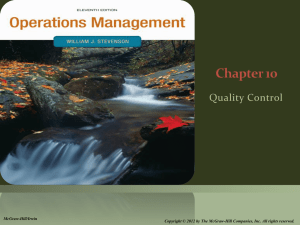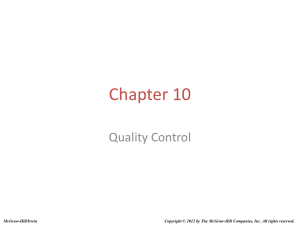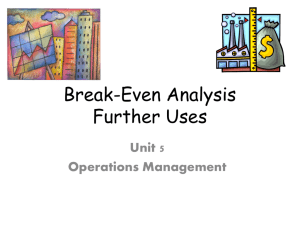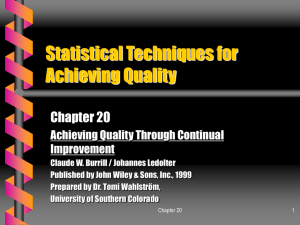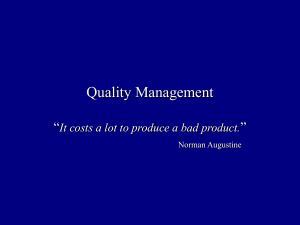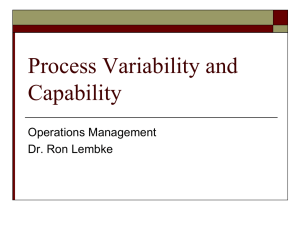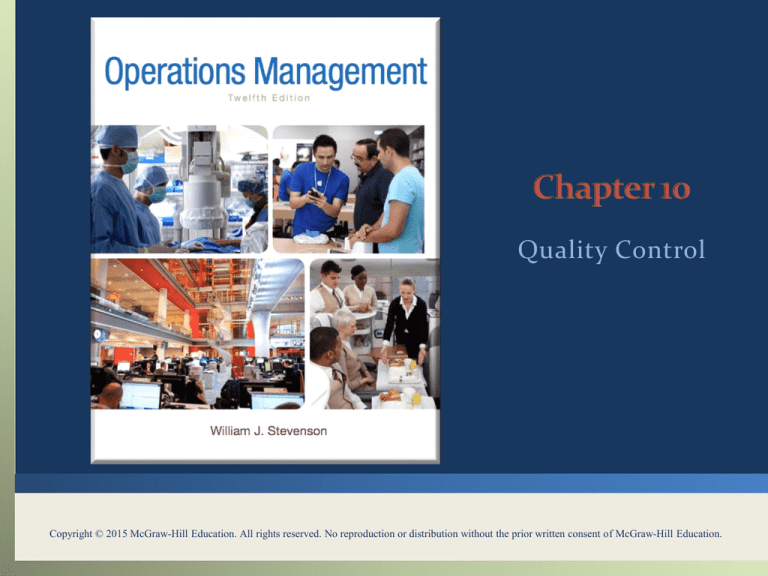
Quality Control
Copyright © 2015 McGraw-Hill Education. All rights reserved. No reproduction or distribution without the prior written consent of McGraw-Hill Education.
You should be able to:
LO 10.1
LO 10.2
LO 10.3
LO 10.4
Explain the need for quality control
Discuss the basic issues of inspection
List and briefly explain the elements of the control process
Explain how control charts are used to monitor a process, and
the concepts that underlie their use
LO 10.5 Use and interpret control charts
LO 10.6 Perform run tests to check for nonrandomness in process output
LO 10.7 Assess process capability
10-2
Quality Control
A process that evaluates output relative to a standard
and takes corrective action when output doesn’t meet
standards
If results are acceptable no further action is required
Unacceptable results call for correction action
Inspection alone is not is generally not sufficient to
achieve a reasonable level of quality
Most organization rely upon some inspection and a great deal
of process control to achieve an acceptable level of quality.
LO 10.1
10-3
Inspection
An appraisal activity that compares goods or services to
a standard
Inspection issues:
1.
2.
3.
4.
LO 10.2
How much to inspect and how often
At what points in the process to inspect
Whether to inspect in a centralized or on-site location
Whether to inspect attributes or variables
10-4
Sampling and corrective action are only a part of the
control process
Steps required for effective control:
Define: What is to be controlled?
Measure: How will measurement be accomplished?
Compare: There must be a standard of comparison
Evaluate: Establish a definition of out of control
Correct: Uncover the cause of nonrandom variability and fix it
Monitor: Verify that the problem has been eliminated
LO 10.3
10-5
Control Chart
A time ordered plot of representative sample statistics
obtained from an ongoing process (e.g. sample means),
used to distinguish between random and nonrandom
variability
Control limits
The dividing lines between random and nonrandom
deviations from the mean of the distribution
Upper and lower control limits define the range of acceptable
variation
LO 10.4
10-6
Variables generate data that are measured
Mean control charts
Used to monitor the central tendency of a process.
“x-bar” charts
Range control charts
Used to monitor the process dispersion
R charts
LO 10.5
10-7
k
k
x
xi
i 1
i 1
k
where
x Average of sample means
x i mean of sample i
k number of samples
LO 10.5
R
R
i
k
where
R Average of sample ranges
Ri Range of sample i
10-8
Used to monitor the central tendency of a process
x chart Control Limits
UCLx x A2 R
LCLx x A2 R
where
A2 a control chart factor based on sample size, n
LO 10.5
10-9
Used to monitor process dispersion
R Chart Control Limits
UCLR D4 R
LCLR D3 R
where
D3 a control chart factor based on sample size, n
D4 a control chart factor based on sample size, n
LO 10.5
10-10
Attributes generate data that are counted.
p-Chart
Control chart used to monitor the proportion of defectives in
a process
c-Chart
Control chart used to monitor the number of defects per unit
LO 10.5
10-11
Even if a process appears to be in control, the data may
still not reflect a random process
Analysts often supplement control charts with a run
test
Run test
A test for patterns in a sequence
Run
Sequence of observations with a certain characteristic
LO 10.6
10-12
LO 10.6
10-13
Once a process has been determined to be stable, it is
necessary to determine if the process is capable of
producing output that is within an acceptable range
Tolerances or specifications
Range of acceptable values established by engineering design or
customer requirements
Process variability
Natural or inherent variability in a process
Process capability
The inherent variability of process output (process width)
relative to the variation allowed by the design specification
(specification width)
LO 10.7
10-14
UTL - LTL
Cp
6
where
UTL upper tole rance (specifica tion) limit
LTL lower tole rance(spec ification) limit
LO 10.7
10-15

